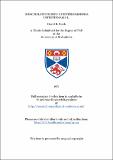Files in this item
Ionic relationships of enteromorpha intestinnalis l.
Item metadata
| dc.contributor.advisor | Weeks, David C. | |
| dc.contributor.author | Black, David R. | |
| dc.coverage.spatial | xxii, 145 p. | en_US |
| dc.date.accessioned | 2018-06-18T15:17:42Z | |
| dc.date.available | 2018-06-18T15:17:42Z | |
| dc.date.issued | 1971 | |
| dc.identifier.uri | https://hdl.handle.net/10023/14213 | |
| dc.description.abstract | The green alga Enteromorpha intestinalis (L. Link) has been observed to grow over a wide range of salinities, from 0.1% to 100% sea water, the optimum grown range being between about 30% and 70% sea water. The range of salinities in which the alga occurs is unusually wide for a marine alga, and an investigation of its ionic relationships was therefore undertaken. Measurements have therefore been made of concentrations of the major ions (Na, K and C1) in the plant cells and in sea water together with measurements of cell membrane potential and ion flux rates. Measurements of the electrical potential difference across the plasmalemma and the influx and efflux of each ion indicate that K and C1 are actively imported and Na actively exported over the whole salinity range. Estimates of cell permeability to the passive diffusive fluxes of these three ions alone have been used to explain the origin of the cell membrane potentials over the range of salinities. Tracer ion kinetics are taken as showing that the tonoplast is more permeable than the plasmalemma to each ion. The ion fluxes against their electro-chemical potential gradients consist of at least two components, one active, the other passive, the passive component has been calculated, for each ion, from the Goldman flux equations. The remaining putative active flux components have been compared with the measured active fluxes and the interlinkages of the latter have been determined. None of the active transport mechanisms for each ion appear to be electrogenic neither do they appear to be 1:1 coupled exchange transport as all the active fluxes are affected by the lowering of temperature and by certain metabolic inhibitors. Use of such inhibitors has enabled division of the fluxes into their component parts. A component of the active K influx and a component of the active Na efflux are linked through a ouabain sensitive transport mechanism. A further component of the active K influx is ouabain insensitive but is dependent upon c1, and further, a part of this C1 dependent K influx requires light while the remainder does not. the active C1 influx has a light dependent component, part of which appears to require both K and Na specifically, the remainder being cation independent. This interlinkage of active fluxes appears to be maintained at all dilutions of sea water as the influxes and effluxes of each ion remain in constant proportion to one another and to the fluxes of other ions over the whole salinity range investigated. The ratio of internal concentration to external concentration, for each ion, increases with increasing dilution although the rations of the internal ions to one another remain reasonably constant. When plants are maintained in solutions of varying sodium to potassium ratio the internal sodium to potassium ratio differs markedly from that found in plants growing in sea water; the plants in such experimental solutions, however, appear to be able to tolerate these internal ionic rations and have remained healthy in such solutions for at least seven days. The majority of plants require a constant internal ionic environment for efficient functioning of their metabolism. This does not appear to be the case with D. intestinalis which may account for its ability to inhabit regions of widely varying salinity. | en_US |
| dc.language.iso | en | en_US |
| dc.publisher | University of St Andrews | |
| dc.subject.lcc | QK569.E6B6 | en |
| dc.subject.lcsh | Enteromorpha | en |
| dc.title | Ionic relationships of enteromorpha intestinnalis l. | en_US |
| dc.type | Thesis | en_US |
| dc.type.qualificationlevel | Doctoral | en_US |
| dc.type.qualificationname | PhD Doctor of Philosophy | en_US |
| dc.publisher.institution | The University of St Andrews | en_US |
This item appears in the following Collection(s)
Items in the St Andrews Research Repository are protected by copyright, with all rights reserved, unless otherwise indicated.

